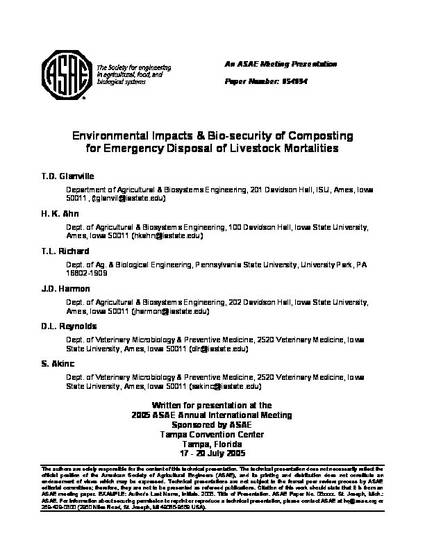
Carcass degradation rate, environmental impacts, and bio-security of windrow-type composting test units were monitored in replicated seasonal trials to assess the feasibility of using composting for emergency disposal of cattle and other large livestock carcasses. Internal temperatures were highest in test units constructed with corn silage. Test units constructed with ground cornstalks or straw and manure were generally 10-20 °C cooler. O2 concentrations in the core of ground cornstalk test units typically exceeded 15%, while those in corn silage and straw/manure test units were in the 5-10% range during the initial weeks of the trials. Despite differences in core temperature and O2 concentration, soft tissue degradation rates were the same in all test units, taking 4-6 months in units constructed during warm weather, and 8-10 months during cold-weather. It is believed that the less favorable (lower) temperatures in the cornstalks may have been offset by significantly higher O2 concentrations which favor rapid aerobic decomposition. Thirty to 45 cm of cover material proved effective in absorbing and retaining odorous gases and leachate. Odors samples collected from the surface of the mortality composting piles typically had low threshold values (< 1500) that differed little from odors emitted by stockpiles of the cover material alone. Leachate volumes were <2% of the precipitation falling on the test units, and preliminary analyses of 1.2 m soil cores show only slight increases in total C and N concentrations in the top 45 cm. Biosecurity tests indicated that pathogens were effectively retained and inactivated: vaccine strains of two avian viruses were inactivated in <21 days; and <2% of sentinel poultry located near the test units exhibited an immune system response to these viruses.
Available at: http://works.bepress.com/thomas_glanville/38/

This is an ASAE Meeting Presentation, Paper No. 054094.